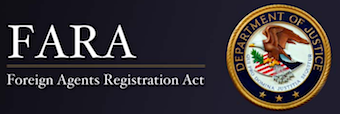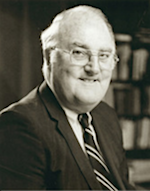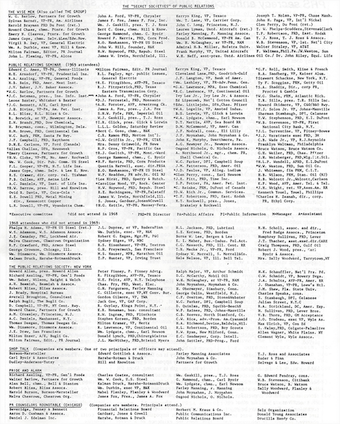The Museum of PR, in putting the spotlight on PR founder Ivy Lee, is also putting the spotlight on the need for a thorough history of PR.
According to a thesis by California Fullerton grad student Tyrone Steven Bomba, later called "exaggerated" by PR historian Scott Cutlip, Lee came to grief because of his firm's alleged secret work for the government in the early 1930s.
 |
Carl Byoir & Assocs. worked for the German Travel Bureau and also drew Congressional criticism. An enraged Congress passed the Foreign Agents Registration Act in 1938 requiring PR firms to file details of any work for foreign governments or entities under their control.
The few PR firms in existence in the early 20th century days did not ordinarily reveal clients. Some clients could be observed such as Lee’s work for the Rockefeller family.
|
|
According to research by sociologists David Miller and William Dinan, published in A Century of Spin, Lee met both Hitler and foreign minister Herman Goebbels in 1934 in a meeting set up by Max Illgner of I.G. Farben, the client of Lee. Lee advised Goebbels to stop propaganda efforts in the U.S., according to Prof. Ray Hiebert, author of Courtier to the Crowd, a 1966 bio of Lee. Goebbels then made a conciliatory speech to foreign diplomats.
Cutlip, in an extensive examination of the Lee/Nazi government involvement, called the charges against Lee "exaggerated, somewhat distorted."
Lee died at the age of 57 on Nov. 8, 1934, of a brain hemorrhage while “under clouds of suspicion for representing the German Dye Trust long after Hitler’s Nazi’s came to power,” wrote Cutlip, a professor at the University of Georgia, in The Unseen Power: Public Relations: A History, published in 1994.
Cutlip noted that the New York Times said Lee was paid $25K by the Trust and son James, who worked in Berlin, got $33K. “Rockefeller Aide Nazi Mastermind” headlined Editor & Publisher. The Jewish Daily Forward called Lee “an agent of the Nazi government.”
Thesis Focused on Lee and Germans
Details of Lee’s work for the Hitler government are also in Tyrone Steven Bomba’s 224-page master’s thesis “Howling with the Wolves: Ivy Lee and the Germans” published in 1982.
Hiebert and Prof. Burton St. John of Old Dominion University, Norfolk, Va., were not familiar with Bomba’s thesis when this reporter described it to them at the Museum of PR session on Lee March 29 at Baruch College.
However, both and Shelley Spector, administrator of the Museum, are seeking copies of the thesis so it can be reported on and made part of the section on Lee. O’Dwyer’s is also seeking to purchase a copy from the ProQuest manuscript service since an office copy cannot be located.
Bomba drew on Lee’s own papers and testimony from the Nuremberg trials.
Son James Lee Worked in Berlin
Lee went to at least one mass rally for Hitler, writing it was “a great show,” said Bomba. He met Hitler for a half hour at one point, saying he “is personally an industrious, honest and sincere hardworking individual.”
Lee’s son, James, wrote a 35-page booklet called “Driving Your Own Car in Germany.”
Lee told the U.S. House Un-American Activities Committee that the booklet had nothing to do with politics.
An anti-Nazi rally calling for a boycott of German goods, because of the persecution of Jews in Germany, was held at Madison Square Garden in March 1933 and in 70 other U.S. cities.
Prof. Hiebert said, “In the end, Lee felt deeply misunderstood.”
He said Lee was reluctant to write about himself because he thought no one would be interested. Lee felt his role was to present the views of others.
Moderator Fraser Seitel summed it up this way at the March 29 event: “Lee felt he was a failure while PR founder Edward Bernays felt he was a success.” Bernays, who authored The Engineering of Consent,” felt PR could “control and regiment the masses according to our will without them knowing it.” The approach of Lee, who had a journalism background, was to provide as many facts as his clients would allow with the aim of “shining the light” said Seitel.
Hiebert Mentions “The Wise Men”
Hiebert’s noting that he is aware of a New York group called “The Wise Men” raised the subject of “The Secret Societies of PR” that has been a staple of O’Dwyer coverage for many years.
Membership lists of seven such groups were published in 1970.
The Wise Men was started by John Hill, founder of Hill & Knowlton, at a dinner party in his apartment in 1938. Forty top PR executives, all male, were listed. Women have been in this group for many years.
Listed by name and title were 150 PR executives who attended the annual meeting of a group called “PR Seminar” which changed its named to Seminar in 2007. Speakers at the four-day meetings at top-level resorts included editors and publishers of major media such as the New York Times, Bloomberg’s, Time, Fortune, Wall Street Journal and Business Week as well as leading academicians and business figures
Membership lists were also given for PR Society: New York, top corporate and PR firm executives who met monthly until 2013; Shop Talk, comprised of top execs at major New York PR firms; Pride & Alarm, New York PR execs who reportedly created the “Accreditation” program that was adopted by PR Society of America, and PR Counselors Roundtable of Chicago, made up of PR firm execs.
Era of Openness Ended
The 1970s through 2000 was a period of “openness” in PR that saw directories of members and their contact points published by PR groups such as PRSA, International Assn. of Business Communicators, National Investor Relations Institute, and Publicity Club of New York, among others.
The Overseas Press Club’s 3,700 members included about 1,500 PR people whose contact points were listed. O’Dwyer’s Directory of Corporate Communications, listing contacts at 6,000+ companies, associations and government offices, was published from 1975-2005.
Most of the other directories had ceased publishing by 2005. Membership lists are now available only to members.
PR Periods Need Studying
While the life of Lee deserves study, an even more compelling need is studying the current state of PR and contrasting how it was practiced from the 1960’s to around 2,000.
A leadership role is being assumed by the Museum of PR and those associated with the Arthur W. Page Center at Penn State University who are advocating a more active role for PR in the public arena.
Dick Martin, former XVP of PR of AT&T, told the first annual dinner of the Page Center Feb. 22 that the PR industry needs a PR counterpart to the Ad Council which has created public interest campaigns for 75 years.
Both PR and the media have credibility problems, the event was told. Alan Murray, chief content officer of Time Inc. and editor-in-chief of Fortune, said the public could only be informed if journalists and PR pros work together.
A member of the Page Center board is Ellyn Fisher, SVP-PR of the Ad Council. The Council has yet to comment on Martin’s suggestion of a PR equivalent of the Council.
An increased focus on PR will be created this year because it is the 70th anniversary of the founding of the world’s biggest PR association, the 21,000-member Public Relation Society of America.

 Scott Cutlip
Scott Cutlip


 Have a comment? Send it to
Have a comment? Send it to 
No comments have been submitted for this story yet.